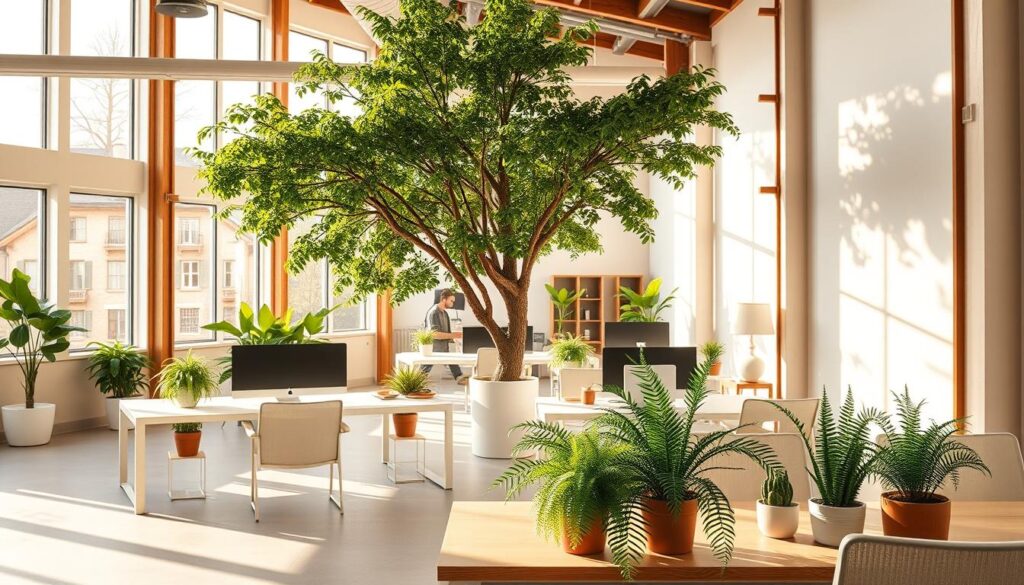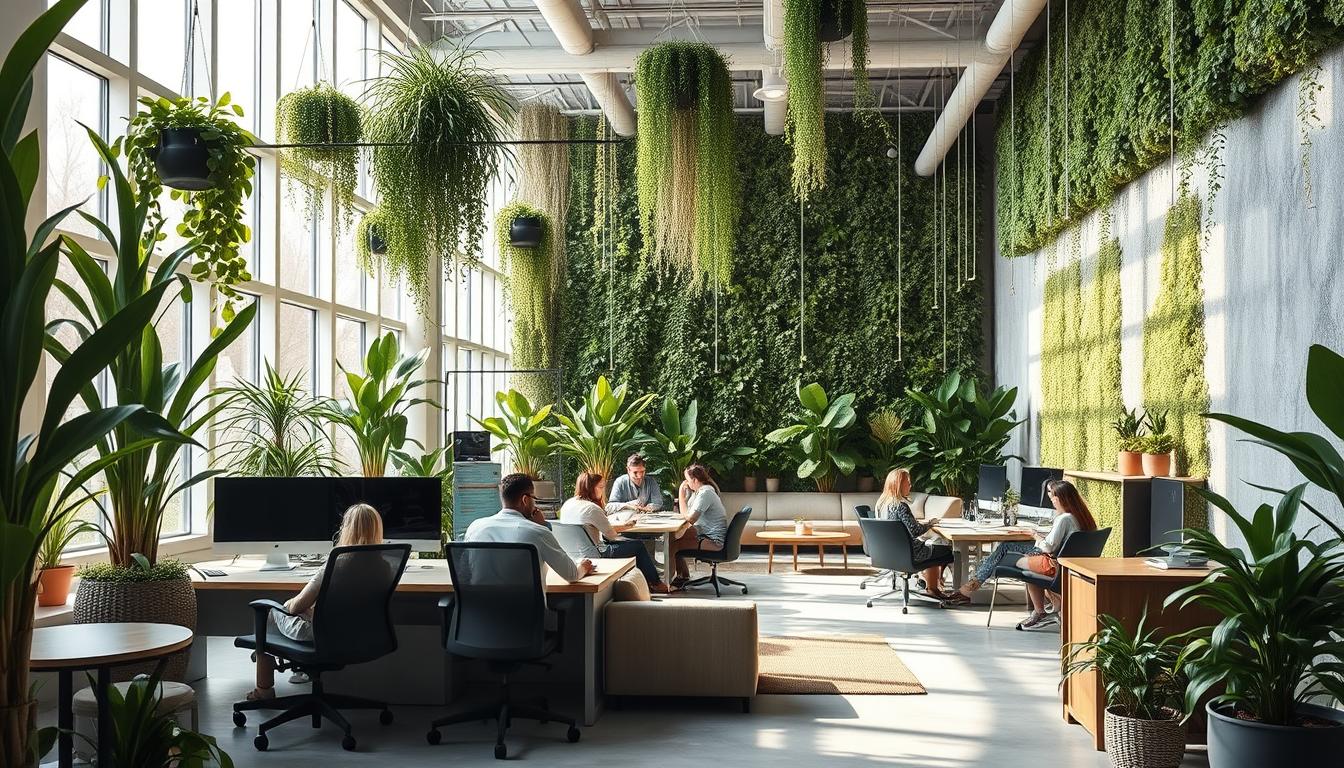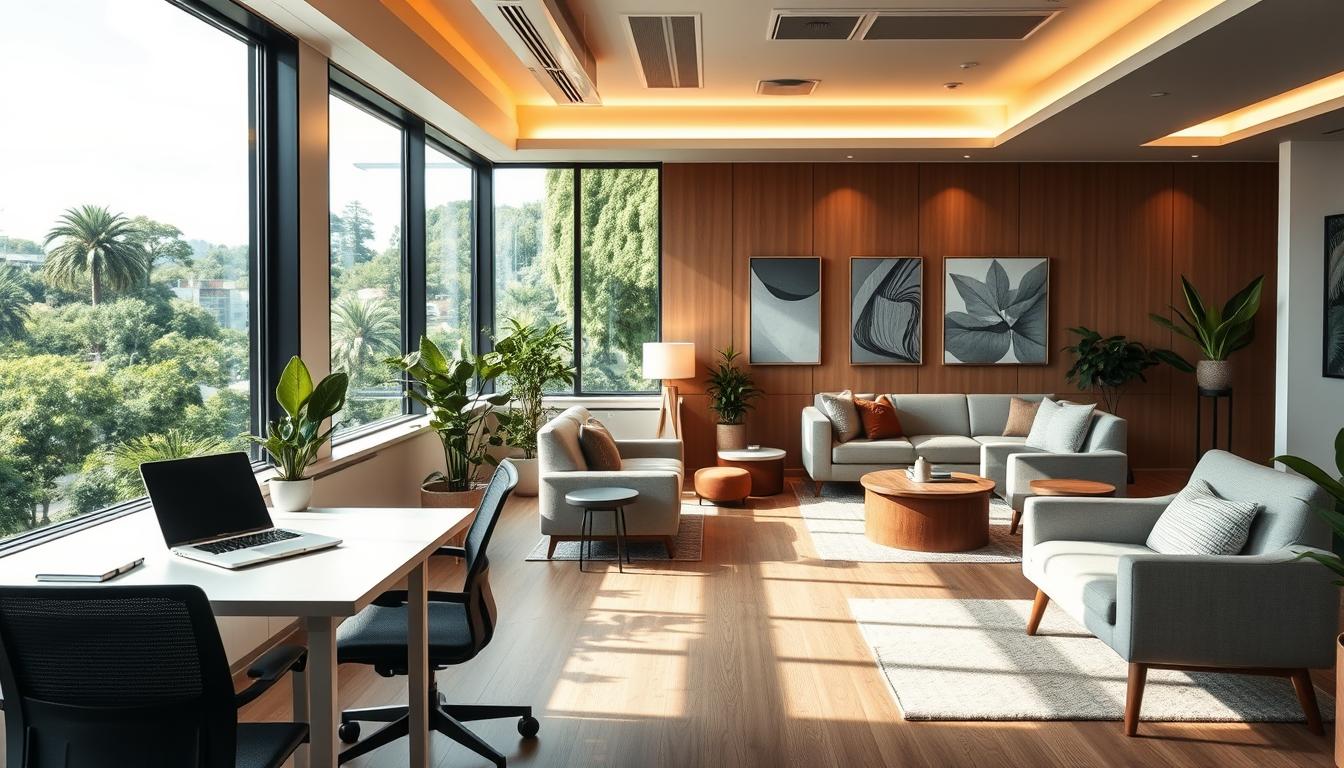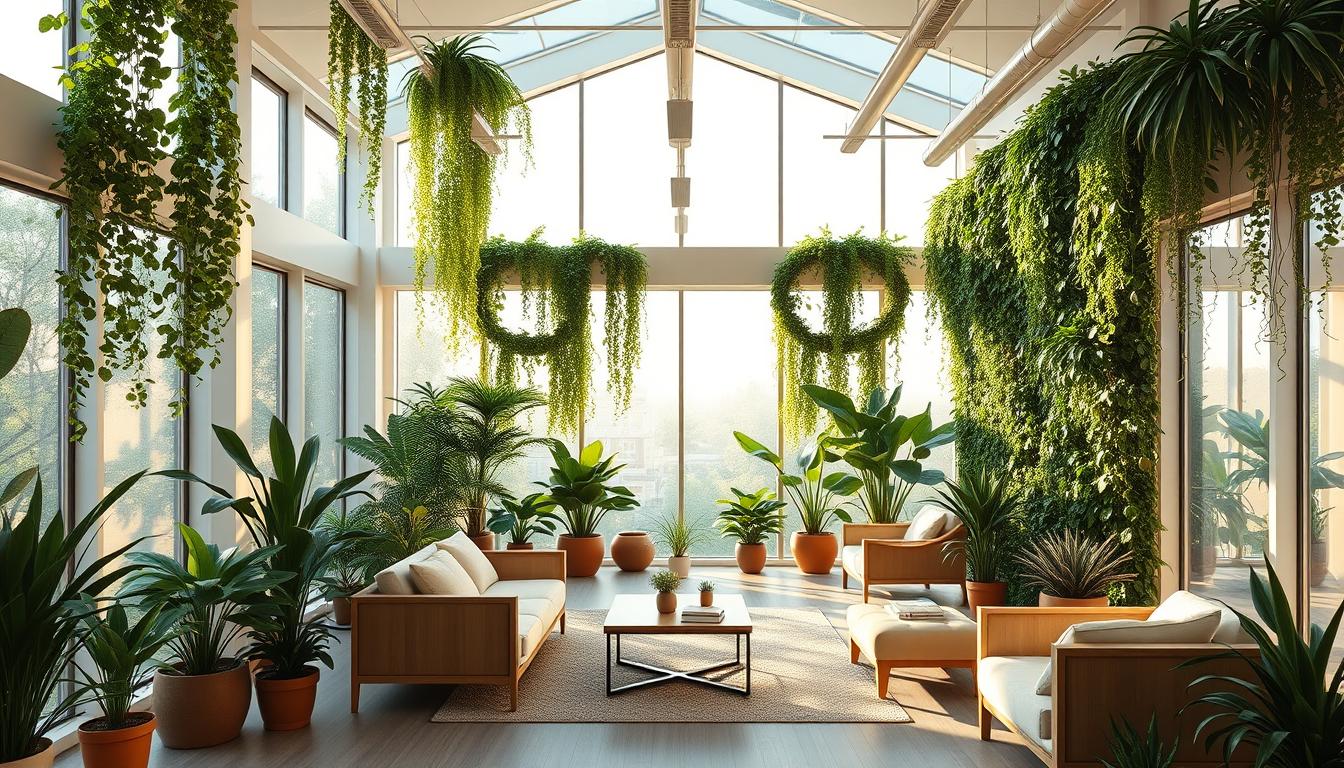In today’s speedy work world, making offices green and comfy is key. This guide talks about how things like light, sound, warmth, and greenery boost work and health. By adding natural bits and smart design, workplaces become better, making everyone happier and more into their work.
Understanding Green Workspaces and Their Importance
Green workspaces have changed how offices are designed. They focus on sustainability and making employees happy. These spaces use eco-friendly office methods to lower environmental harm and boost workplace happiness.
Definition of Green Workspaces
Green workspaces use sustainable materials and energy-saving tech. They let in plenty of natural light. The aim is to cut down on energy use and make a healthier place for workers. By doing this, we can achieve a sustainable workplace that’s good for the earth and people.
Benefits of Green Design in the Workplace
Green design does more than help the planet. It creates healthier places to work, which makes employees happier and more productive. Quality air and natural light improve focus and creativity. They also lessen stress.
Companies with green practices save on energy costs and have happier workers. This makes their workplace more attractive to the best employees.

The Role of Sensory Comfort in Employee Well-Being
Sensory comfort is key in making a work environment where employees thrive. It not only boosts their well-being but also their work output. By focusing on sensory needs, companies can create spaces that fit what employees like. This makes them happier with their jobs.
Impact of Sensory Factors on Productivity
The way sensory factors influence work is significant. Lighting, noise, and temperature affect how well employees can do their jobs. For example:
- Bright, even lighting helps people focus and eases eye strain.
- Keeping noise low helps everyone stay focused and do more.
- A comfortable temperature keeps distractions low.
How Comfort Enhances Focus and Engagement
Comfort at work is vital for making employees dive into their tasks. When they feel good, they’re more into their work. Letting them adjust their spaces to what they prefer makes them happier. This satisfaction makes them more connected to their work and the company.
Sensory Comfort in Green Workspaces: Key Elements
To create comfort in green workspaces, we need key pieces. These include managing lighting, sound, and air quality right. They help employees feel good and work well. Together, they boost focus and cut down on distractions. This lets everyone work better.
Lighting Control for Enhanced Comfort
Light affects how we feel and work. Natural light, that can be adjusted, is best. It helps with mood and focusing. By letting employees change their lighting, they avoid eye problems and feel better. Smart systems adjust the brightness as needed, making spaces perfect for work or relax.
Acoustic Considerations in Workspace Design
Loud noises disrupt work. Using acoustic design for comfort and materials that absorb sound helps a lot. Things like partitions that block sound, carpets, and special ceiling panels lower noise. This makes the workplace calmer, so people can concentrate and do their jobs better.
Temperature and Air Quality Management
Good air and the right temperature are vital. Air quality management keeps air fresh and clean. This stops the air from getting old and stale. Having a comfy temperature also keeps everyone healthy and productive. It shows how crucial air and temperature control are in designing a workspace.
The Benefits of Biophilic Design in Workspaces
Adding biophilic design to workspaces changes how employees relate to their environment. It mixes nature into the workplace, greatly lifting sensory experiences. Things like plants, water features, and lots of daylight make the atmosphere better and more productive.
This design goes beyond looking good. It boosts overall well-being, increasing job satisfaction and work quality.
How Nature Elements Affect Sensory Experience
Nature in the office greatly improves how employees feel. When they see plants or natural light, they feel more at ease and engaged. Adding indoor plants can make people happier and more creative, making an office welcoming.
This helps workers do better by using nature’s positive vibes.
Improving Air Quality and Reducing Stress
Indoor plants are key in making air cleaner by taking out pollutants and making oxygen. This helps employees think clearer and stay focused. Besides cleaner air, nature in the office lowers stress.
Studies show that nature-filled places can reduce stress hormones, making a calm workspace. This environment helps employees do well and enjoy the benefits of biophilic design.
Creating Flexible and Adaptive Spaces
Modern work environments need flexible workspaces. They must meet different employee needs. Adaptive office designs include many work zones. These range from team spaces to quiet solo work areas. By making these areas, job satisfaction and productivity go up.
Importance of Varied Work Zones
Varying work zones boost creativity and adaptability. Employees pick spaces that fit their tasks, like quiet spots or team areas. This supports their work styles and makes the office lively.
Adjustable Furniture for Personal Comfort
Adjustable furniture makes the workspace more comfortable. Workers use standing desks and changeable seating. This lets them set up their workstations for comfort and the task.
Such flexibility betters ergonomics and boosts engagement and productivity. It makes employee well-being a focus by meeting sensory needs.
Incorporating Indoor Plants for a Healthier Environment
Adding indoor plants to the workplace does wonders, especially for the air quality in offices. These plants are not just nice to look at. They help make the space welcoming. Plants that clean the air and boost oxygen levels make work environments healthier.
Air Quality Benefits of Indoor Plants
Plants make the air in offices better. They take in pollutants and give out oxygen. This makes the air fresher for everyone. Studies show that offices with plants have less carbon dioxide and harmful chemicals in the air. This boosts focus and makes everyone feel better. It shows how great indoor plants are for work places.
Selection of Low-Maintenance Plants for Offices
It’s smart to pick office plants that are easy to take care of. Some top choices are:
- Peace lilies
- Spider plants
- Snake plants
- Pothos
These plants do well in different light and are easy to keep alive. They let offices have cleaner air without adding work for the staff. By picking these plants, companies can enjoy cleaner air without much effort.
Design Strategies for Sensory-Friendly Workspaces
Making a workspace sensory-friendly takes planning. You need to choose colors and manage sound well. Doing so makes workers more comfortable and productive.
Utilizing Color Psychology in Workspace Design
Color psychology is very important in the office. Picking calming blues and greens makes a peaceful space. These colors help people stress less, think better, and be more creative.
Sound Management Techniques for Focus
Managing noise is also key. Using acoustic panels helps soak up sound. Quiet areas help people focus better. With these steps, a workspace meets many sound needs, supporting a sensory-friendly design.
Case Studies: Successful Implementation of Sensory Comfort
Real-world examples show how organizations are boosting employee well-being with green workspaces. They apply sensory comfort principles in different ways. This enhances productivity and employee satisfaction.
Examples of Green Workspaces Promoting Well-Being
Companies like Google and Microsoft lead with creative office designs. They focus on making employees feel good. Google’s offices have gardens and living walls to link people with nature. This creates a peaceful space and shows how well sensory comfort works.
- Biophilic break rooms with natural light and green views
- Quiet zones for relaxation and focused work
- Community spaces featuring adaptable furniture for varying tasks
Innovative Designs from Leading Companies
Steelcase and Herman Miller also offer cutting-edge office designs that stress flexibility. They provide modular furniture that fits personal needs. These setups boost comfort and help people work together well. It shows the success of adding sensory elements to offices.
- Versatile workstations that adjust for both standing and sitting
- Sound-masking systems that enhance acoustic comfort
- Sustainable materials that contribute to a healthier workspace
Conclusion
It’s key to see how green workspaces aren’t just about being eco-friendly. They also boost employee wellness. They make people feel good by being well-designed. This is because happier workers are more productive. So, making an office green is super important.
Natural light, clean air, and quiet spaces make workers happier. Green offices make people feel healthier and more involved in their work. By focusing on how our senses interact with the office, companies can make everyone feel better and work better.
Looking ahead, it’s important for companies to focus on these areas as office culture changes. The mix of caring for the planet and caring for workers will lead the way. This shows how important both good design and thinking about workers’ experiences are.



